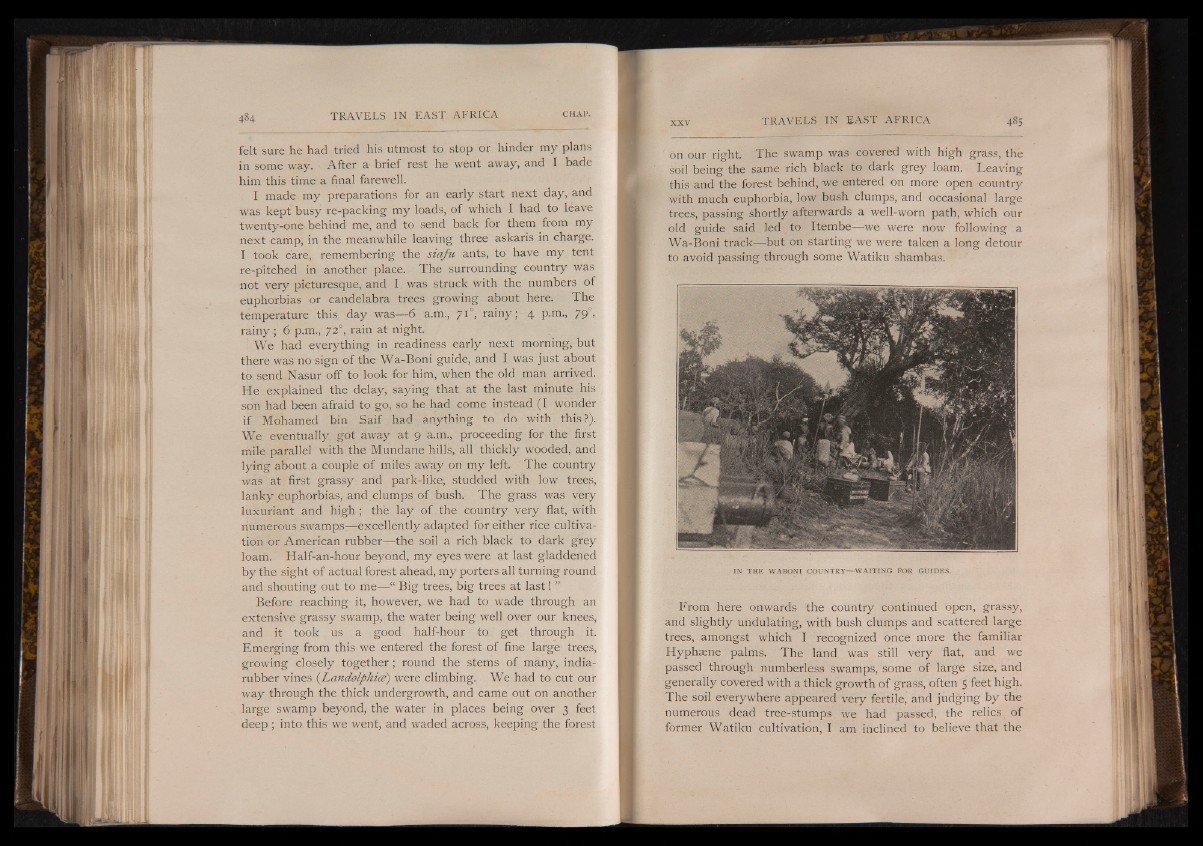
felt sure he had tried his utmost to stop or hinder my plans
in some way. After a brief rest he went away, and I bade
him this time a final farewell.
I made my preparations for an early start next day, and
was kept busy re-packing my loads, of which I had to leave
twenty-one'behind me, and to send back for them from my
next camp, in the meanwhile leaving three askaris in charge.
I took care, remembering the stafu ants, to have my tent
re-pitched in another place. The surrounding country was
not very picturesque, and I was struck with the numbers of
euphorbias or candelabra trees growing about here. The
temperature this day was— 6 a.m., 71°, rainy; 4 p.m., 79°,
rainy ; 6 p.m., 72°, rain at night.
We had everything in readiness early next morning; but
there was no sign of the Wa-Boni guide, and I was just about
to send Nasur off to look for him, when the old man arrived.
He explained the delay, saying that at the last minute his
son had been afraid to go, so he had come instead (I wonder
if Mohamed bin Saif had anything to do with this?).
We eventually got away at 9 a.m., proceeding for the first
mile parallel with the Mundane hills, all thickly wooded, and
lying about a couple of miles away on my left. The country
was at first grassy and park-like, studded with low trees,
lanky .euphorbias, and clumps of bush. The grass was very
luxuriant and high; the lay of the country very flat, with
numerous swamps;—excellently adapted for either rice cultivation
or American rubber— the soil a rich black to dark grey
loam. Half-an-hour beyond, my eyes were at last gladdened
by the sight of actual forest ahead, my porters all turning round
and shouting out to me— “ Big trees, big trees at last! ”
Before reaching it, however, we had to wade through an
extensive grassy swamp, the water being well over our knees,
and it took us a good half-hour to get through it.
Emerging from this we entered the forest of fine large trees,
growing closely together; round the stems of many, india-
rubber vines (Landolphice) were climbing. We had to cut our
way through the thick undergrowth, and came out on another
large swamp beyond, the water in places being over 3 feet
deep ; into this we went, and waded across, keeping the forest
on our right. The swamp was covered with high grass, the
soil being the same rich black to dark grey loam. Leaving
this and the forest behind, we entered on more open country
with much euphorbia, low bush clumps, and occasional large
trees, passing shortly afterwards a well-worn path, which our
old guide said led to Itembe— we were now following a
Wa-Boni track— but on starting we were taken a long detour
to avoid passing through some Watiku shambas.
IN THE WABONI COUNTRY— WAITING FOR GUIDES.
From here onwards the country continued open, grassy,
and slightly undulating, with bush clumps and scattered large
trees, amongst which I recognized once more the familiar
Hyphsene palms. The land was still very flat, and we
passed through numberless swamps/some of large size, and
generally covered with a thick growth of grass, often 5 feet high.
The soil everywhere appeared very fertile, and judging by the
numerous dead tree-stumps we had passed, the relics of
former Watiku cultivation, I am inclined to believe that the